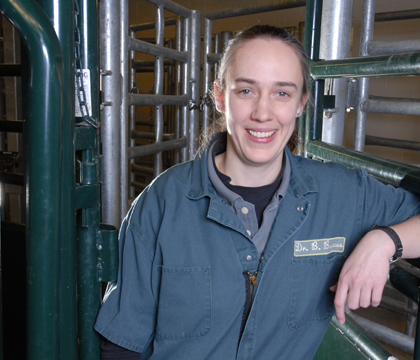
Seminars arm vets with infection control skills
When large animal internist Dr. Brandy Burgess talks about infection control and biosecurity with western Canadian veterinarians in early June, her aim is to have them leave her seminars with the knowledge and skills they need to investigate and manage an infectious disease outbreak.
By Robyn Thrasher
"My intent is to provide attendees with a basic understanding of infection control as it pertains to the veterinary hospital environment as well as how to apply those principles to practising in the field," explains Burgess, one of the presenters at the Western College of Veterinary Medicine's 2012 June Conference, June 7 to 9.
Originally from Montana, Burgess attended veterinary school at Colorado State University (CSU). Between her first and second year, Burgess was selected as a Merck-Merial summer scholar and worked closely with Dr. Paul Morley, an epidemiologist and the director of biosecurity at the CSU Veterinary Teaching Hospital (CSU-VTH).
"During this experience, it became clear to me that my professional interests lay both in epidemiology and infection control," says Burgess, now the biosecurity house officer at the CSU-VTH.
After earning her Doctor of Veterinary Medicine (DVM) degree in 2005, Burgess completed an internship and residency in large animal internal medicine at the WCVM.
"I feel very fortunate to have received training at the WCVM," says Burgess, who was a familiar face at the WCVM from 2005 to 2009.
"They offer one of the few residency programs that allow you to practise on a wide range of large animal species. As a result, I was trained by many different clinicians including Drs. Chris Clark, Lyall Petrie, Katharina Lohmann and Fernando Marqués. I see a little bit of each of them in the way that I practise veterinary medicine today, and for that, I am grateful."
Burgess is now completing a residency in infection control and working on a PhD in epidemiology at CSU. Her most recent research focuses on Salmonella in veterinary hospitals.
"I'm investigating the risk factors for animal shedding and environmental contamination with Salmonella enterica," she says. "My ultimate goal is to develop a model that will allow the assessment of different preventive measures that may reduce the risk of hospital-acquired Salmonella infections."
According to Burgess, the WCVM's June conference is an excellent opportunity to interact with private practitioners.
"It's a chance to share with them not only what I do, but to provide them with the most up-to-date information in my area of expertise," she says.
Originally from Montana, Burgess attended veterinary school at Colorado State University (CSU). Between her first and second year, Burgess was selected as a Merck-Merial summer scholar and worked closely with Dr. Paul Morley, an epidemiologist and the director of biosecurity at the CSU Veterinary Teaching Hospital (CSU-VTH).
"During this experience, it became clear to me that my professional interests lay both in epidemiology and infection control," says Burgess, now the biosecurity house officer at the CSU-VTH.
After earning her Doctor of Veterinary Medicine (DVM) degree in 2005, Burgess completed an internship and residency in large animal internal medicine at the WCVM.
"I feel very fortunate to have received training at the WCVM," says Burgess, who was a familiar face at the WCVM from 2005 to 2009.
"They offer one of the few residency programs that allow you to practise on a wide range of large animal species. As a result, I was trained by many different clinicians including Drs. Chris Clark, Lyall Petrie, Katharina Lohmann and Fernando Marqués. I see a little bit of each of them in the way that I practise veterinary medicine today, and for that, I am grateful."
Burgess is now completing a residency in infection control and working on a PhD in epidemiology at CSU. Her most recent research focuses on Salmonella in veterinary hospitals.
"I'm investigating the risk factors for animal shedding and environmental contamination with Salmonella enterica," she says. "My ultimate goal is to develop a model that will allow the assessment of different preventive measures that may reduce the risk of hospital-acquired Salmonella infections."
According to Burgess, the WCVM's June conference is an excellent opportunity to interact with private practitioners.
"It's a chance to share with them not only what I do, but to provide them with the most up-to-date information in my area of expertise," she says.
"In return, I learn about what's important to private practitioners and what gaps they've identified in the current state of knowledge with respect to infection control and outbreak management."
